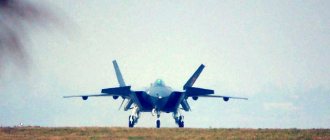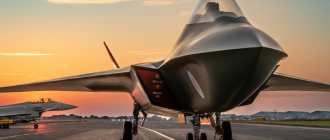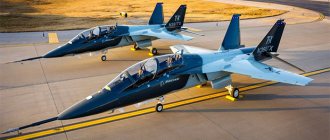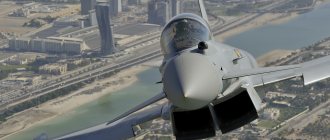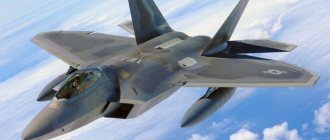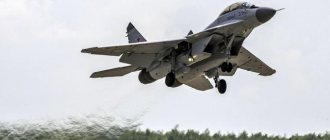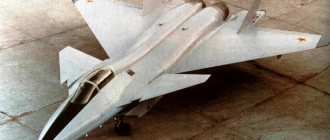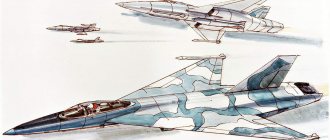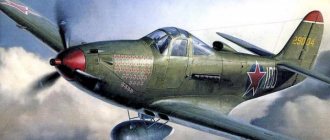The most important alterations were the replacement of the unfinished AM-37 engine with a less powerful, but already serial AM-35A, modification of the oil cooling system and new wooden wing consoles. The shortage of duralumin and equipment for working with metal was felt in the USSR aircraft industry already in the last pre-war years, which forced new wing consoles to be made for the I-200.
The MiG-3 fighter, produced in December 1940, is standard equipped with armament of two 7.62 mm ShKAS machine guns and one 12.7 mm BS in synchronous installations above the engine and the transceiver radio station Photo: OKB im. A.I. Mikoyan // https://www.migavia.ru/images/9may
And even when the desired entry on the aircraft’s compliance with the requirements of the Red Army Air Force and its adoption into service appeared in the Act based on the results of State tests, the designers still had a lot of work to do. Already at the start of mass production, it was necessary to eliminate an impressive list of shortcomings that should not exist on aircraft in the army. Next, it was necessary to make the improvements requested by the Customer. And finally, we had to think about the future - the MiG should not stand still, we must strive forward!
By the spring of 1940, the new design bureau was already a strong, well-coordinated and qualified team - thanks to Polikarpov! But now, although Nikolai Nikolaevich continued to help with advice and organization, he had to think with his own head and take full responsibility upon himself. It so happened that the new design bureau had two heads and, accordingly, it was necessary to divide responsibilities between them - no one needed “extras” at that tense time.
Artem Ivanovich Mikoyan graduated from the Air Force Academy, had experience serving in the Air Force and working in the Voenpriemka, and then in the brigade for introducing the I-153 aircraft into series at plant No. 1. General issues naturally came under his jurisdiction - the choice of the appearance of the aircraft being created and the main components taking into account the needs of the Customer and the capabilities of the industry. It was he who decided what each next aircraft created should be.
Mikhail Iosifovich Gurevich was a graduate of the University of Montpellier, the Primary School of Aeronautics in Toulouse and the Kharkov Polytechnic Institute. His task was to decide how best to carry out what Mikoyan had planned. Aviation is a knowledge-intensive industry that requires extensive knowledge from workers. Mikhail Iosifovich had them in abundance.
Thus was born the creative union of two outstanding Soviet aircraft designers, who became famous under the common MiG brand. However, their path to victories and achievements was not easy, and it began in troubled years.
The history of the creation of the MiG-1 aircraft
The design of the new fighter began at Polikarpov's design bureau in November 1939. The new product was planned to be used as a fighter, which should have high flight speeds. It is for this reason that designers paid much attention to the aerodynamics of the body. To improve the streamlining of the car, newer materials were used and the casing of the device was polished with high quality. But, as you know, the power plant, which was quite powerful for this fighter at that time, is mainly responsible for the speed of the aircraft. All this should ensure high speed and excellent control of the aircraft.
The designers planned to reach a flight speed of 670 km/h, while the practical flight ceiling had to be at least 7 kilometers. The vehicle could perform military missions as an attack aircraft or long-range escort fighter. It is worth saying that almost all of the designers’ plans were implemented in the new fighter.
At the end of 1939, the model of the MiG-1 aircraft was approved, and the very next day the designers began working on working drawings. In order for this aircraft to be manufactured as quickly as possible, a large number of workers from different industries were involved. In addition, production was carried out in two shifts and even without days off.
After blowing through the first mock-up of the aircraft, it became clear that the designers had thoroughly thought out the aerodynamics of the aircraft. These studies confirmed the usefulness of the project, and it was sent for further production. The fruitful joint work of the designers led to the fact that in February 1940 the MiG-1 aircraft was transferred to serial production.
This fighter was first presented to the general public in the summer of 1940 at a military parade in Tushino. In the first year of mass production, 100 machines of this type were built, and the next year another 89 devices were ready.
I-200 AM-37
At the beginning of December 1940, the AM-37 engine was installed on the second experimental I-200. The engine was equipped with a crescent-shaped oil cooler, placing it under the front of the engine. The machine gun armament was removed from the prototype aircraft. On January 6, 1941, test pilot A.I. Zhukov took the I-200 AM-37 into the air for the first time. The AM-37 engine experienced unstable operation and shaking at altitude. On April 26, 1941, the I-200 AM-37 was sent to plant No. 24 for engine development, and on May 7 the plane crashed. Test pilot I.T. Ivashchenko untimely switched power to the fuselage fuel tank. The plane was destroyed upon landing and could not be repaired.
Testing of the MiG-1 device
At the very first factory tests, it was clear that this machine had achieved the speed characteristics intended by the designers. In May 1940, the MiG-1 reached a maximum speed of 648.5 km/h; these figures were obtained at a flight altitude of 6.9 kilometers. The second copy of the car, which was tested, showed an even higher speed of 651 km/h. As for the maximum flight altitude, it was 8.5 kilometers. But there were rumors that this machine could rise to a height of more than 11 kilometers, but there is no documentary evidence of this.
The engine installed on the MiG-1 was not always a reliable unit and could sometimes let pilots down. In addition to its capricious nature, the engine also required replacement of engine spark plugs after every three hours of flight, which was also inconvenient. That is why, at the end of 1940, designers began testing a new, more reliable AM-37 engine. This power plant was distinguished by the fact that air was supplied to the carburetor of the device from a supercharger, and this air was pre-cooled using a water radiator. Also, two nine-inch water radiators were installed to cool the water. In addition, a new propeller of the VISH-61 type was used for this engine, which could change the pitch. But all this in practice was not crowned with great success, since already at an altitude of 4 kilometers the engine began to shake and almost stalled.
Experienced models
Solid work at the plant led to the first production of test models of the I-200 in February 1940. The first prototype of the flight prototype "X" was tested in March 1940. Responsible for performing the test: flight engineer A.G. Brunov, senior test pilot of plant No. 1 N.I. Ekatov, two backup pilots, Lieutenant Colonel M.I. Martselyuk and Major M.N. Yakushin. The fighter tested for the first time took off on April 5, piloted by the prototype N.I. Ekatov.
At the end of April, the second copy of the “X” prototype was ready, which was actively subjected to all kinds of checks. Passing the May speed limit test, A.N. Ekatov reached a speed of 648.5 km/h on the first experimental model, at an altitude of 6899 meters, while the engine was in nominal operating mode. Two months later, M.N. Yakushin accelerated the second prototype to 652 km/h, increasing the altitude to 7000 meters.
The parameters taken are as follows: passing the altitude mark of 2220 m - the speed was 579 km/h, at an altitude of 3630 m - the speed reached 605 km/h, the flight time was 5 minutes. And two minutes later he had already reached 7000 m, setting a new speed record.
The third X prototype was slightly different from the first two. Metal consoles have already been installed on it, and a headlight has been installed. He made his first flight on June 6, piloted by test pilot M.I. Martselyuk.
In addition to flight checks, weapons testing was carried out. The plane was equipped with small arms, the shots of which were fired through the propeller, in time with the running engine. Without waiting for the end of flight tests, the Defense Committee issued the NKAP order No. 245 of May 30, 1940 for serial production.
During the air parade in Tushino on August 18, 1940, the Soviet people saw the new winged aircraft for the first time. By the end of the year, more than 100 MiG-1 aircraft will roll off the assembly line of plant No. 1. Approximately the same number will be produced in the first months of 1941.
Design features of the MiG-1 fighter
The aircraft had a design that was very similar to the I-16 aircraft, but there were many differences. The fuselage of the new fighter was made according to the structural layout. The tail section of the vehicle was made as a semi-monocoque, which had additional fastenings made of wooden stingers and frames. The middle and bow compartments of the device were represented by a removable motor mount, which was welded from pipes and covered with duralumin sheets.
MiG-1 video
The center section of the aircraft was manufactured as an all-metal structure. In addition to metals, the design of the machine included wood, from which the wing consoles were made, which led to an increase in weight and less reliability of the wing itself. The designers had to use wood due to an acute shortage of metals.
The power plant was represented by a fairly powerful, but at the same time heavy, AM-35 engine, which should work perfectly at high altitudes with low oxygen content in the air. This engine could produce a power of 1200 horsepower, but it was achieved at altitudes of more than 5 kilometers. The most effective flight was at an altitude of 7 kilometers or more, where the MiG-1 aircraft could reach maximum speed indicators. The closer to the surface of the earth the device flew, the worse the flight characteristics were.
As for the fuel system, in the MiG-1 type aircraft it was represented by two tanks, which were located in the center section of the wings. Further aircraft of this type were equipped with additional tanks for greater range.
In addition to its advantages, the aircraft also had disadvantages, the biggest being the design of the pilot's canopy, which tilted to one side. This opening scheme resulted in the pilot being unable to open the canopy during the flight. The vents, which were supposed to provide ventilation to the pilot's cabin, worked ineffectively and could not provide normal ventilation and cooling in the cabin. These shortcomings were improved, and production MiG-1 aircraft were equipped with a canopy that moved back. The designers also provided a more efficient ventilation and cooling system.
All the shortcomings of the MiG-1 aircraft were identified and improved by the designers. These metamorphoses led to the emergence of a new fighter, which was designated as the MiG-3, which also replaced the MiG-1.
On the way to fighter aircraft
At birth, Mikoyan had the name Anushavan Ovanesovich. Born on August 5, 1905 in the village of Sanahin, Borchali district, Tiflis province (now the city of Alaverdi, Armenia). His father worked at a copper smelter, his mother was a housewife. The elder brother, Anastas Mikoyan, was a famous Soviet statesman and politician, “Stalin’s favorite people’s commissar.”
Artem received his primary two-year education at a rural school. After the death of his father, he continued his studies at an Armenian school in Tiflis (now Tbilisi, Georgia). In 1923, in Rostov-on-Don, he entered the factory apprenticeship school at , and was an apprentice turner. In 1925 he moved to Moscow, where he worked as a turner.
In December 1928, he was drafted into the ranks of the Workers 'and Peasants' Red Army (RKKA). In 1931 he was sent to the Air Force Academy named after Professor N.E. Zhukovsky (now the Air Force Academy named after Professor N.E. Zhukovsky and Yu.A. Gagarin). In 1935, he underwent practical training in Kharkov. Together with other academy students, in 1937 he built his first light aircraft, the Oktyabrenok aircraft, which was highly praised by the Central Aero Club.
Artem Mikoyan © Press service of RSK MiG
In the same year, he defended his graduation project and received the title of military mechanical engineer of the Red Army Air Force and was appointed a military representative at the aircraft plant No. 1 named after. Aviakhim, where the Nikolai Polikarpov Design Bureau was transferred at the beginning of 1939. In March 1939, Artem Ivanovich was transferred from military acceptance to the NKAP - to the Polikarpov Design Bureau, where he was appointed head of KB-1 for maneuverable fighters.
On December 8, 1939, Mikoyan was appointed head of the new Special Design Department (OKO), organized at the same plant. This day became the birthday of the new design bureau. There he will rise to chief designer, and aircraft designer Mikhail Gurevich will become his deputy.
Mikhail Gurevich and Artem Mikoyan © Press service of RSK MiG
Soon after the start of the Great Patriotic War, in October 1941, plant No. 1 was evacuated to Kuibyshev (now Samara). After the return of the OKO team and the experimental workshop to Moscow in March 1942, Mikoyan became the director and chief designer of the pilot plant No. 155 (OKB-155, since 1966 - Moscow Machine-Building Plant). Subsequently, in 1971, the plant was named after A.I. Mikoyan (now the A.I. Mikoyan Design Bureau as part of RSK MiG). In December 1956, Artem Ivanovich was appointed to the position of general designer.
Under the leadership of Mikoyan and Gurevich, 15 aircraft with high performance characteristics were developed in 1940–1945, including the MiG-1 and MiG-3 (1940), which took part in the Great Patriotic War.
Mig-3 aircraft, created by the design bureau of A.I. Mikoyan and M.I. Gurevich / TASS Photo Chronicle
The highest results during the tests were shown by the high-altitude fighter-interceptor I-224 (1944), which rose to a height of 14,100 m, the I-225 (1944), which showed a maximum speed of 726 km/h, as well as the I-250 (1945) with a combined power plant, reaching a speed of 820 km/h using a jet accelerator.
MiG-1 characteristics:
| Modification | MiG-1 |
| Wingspan, m | 10.20 |
| Length, m | 8.15 |
| Height, m | 3.30 |
| Wing area, m2 | 17.44 |
| Weight, kg | |
| empty plane | 2411 |
| normal takeoff | 3099 |
| maximum takeoff | 3319 |
| fuel | 266 |
| engine's type | 1 PD AM-35A |
| Power, hp | 1 x 1350 |
| Maximum speed, km/h | |
| on high | 657 |
| near the ground | 486 |
| Cruising speed, km/h | 466 |
| Practical range, km | 580 |
| Maximum rate of climb, m/min | 1008 |
| Practical ceiling, m | 12000 |
| Crew | 1 |
| Weapons: | two ShKAS machine guns of 7.62 mm caliber (ammunition 1500 rounds) and one BS 12.7 mm caliber (ammunition 300 rounds). |
| four beams of bomb racks, on which 4 bombs with a total weight of up to 220 kg or two VAP-6M pouring devices with a capacity of 50 liters could be suspended. Under each console, 4 RO-82 flute-type rocket guns could also be installed for firing ROS-822 rockets |
Aircraft
Serial production and combat service
Since 1982, even before testing was completed, serial production was launched at the Moscow Machine-Building Plant. The production of RD-33 engines was carried out by the Moscow Engineering Enterprise (now JSC MMP named after V.V. Chernyshev). In July 1983, the first MiG-29s began to arrive at the 234th Guards Fighter Aviation Regiment (Kubinka, Moscow region). In total, over 1.6 thousand copies of the aircraft were manufactured, the production of improved modifications continues to this day.
The fighter was used during combat operations in Afghanistan, various conflicts in the post-Soviet space, in the Persian Gulf countries, Ethiopia, Eritrea, Yugoslavia, India, Yemen, Sudan, and Syria.
According to information from open sources, the Russian Air Force currently has up to 270 MiG-29s of various modifications in service. The Russian Navy operates several dozen such fighters. In particular, in 2016, the 100th naval fighter aviation regiment was formed, equipped with MiG-29K aircraft, which should serve on the only aircraft carrier in the Navy, Admiral Kuznetsov.
Back in Soviet times, MiG-29s were supplied to several Warsaw Pact countries (GDR, Czechoslovakia, Romania), as well as to Yugoslavia and Iraq. After 1991, the MiG-29 was sold not only by Russia, but also by the countries of the former USSR (Ukraine, Moldova). Currently, the fighter is included in the air forces of more than 20 countries.
Modifications
More than twenty modifications of the aircraft have been developed, including:
- Double combat trainer MiG-29UB (“product 9-51”).
- “Product 9-13” - with an increased fuel supply, a new electronic warfare system and an active jamming system.
- MiG-29S (“9-13S”) - with a modernized weapons control system and the ability to use R-77 missiles.
- Deck-based MiG-29K (“9-41”) and MiG-29 KUB (“9-47”).
- MiG-29M (“9-15”) is a deep modernization with a flight range increased to 3.2 thousand km.
- MiG-29SM/SMT (“9-14″/”9-15”) - with the ability to use high-precision air-to-surface weapons.
- The MiG-35 is multifunctional, “4++” generation, with a new phased array radar, a new engine control system, reduced operating costs, and others.
